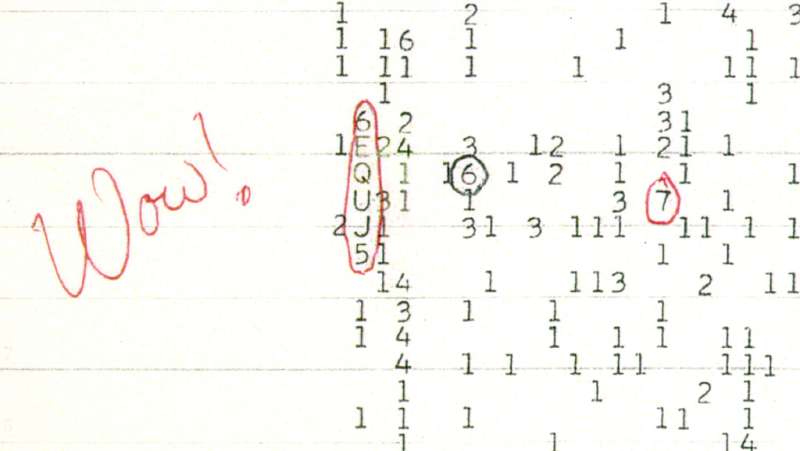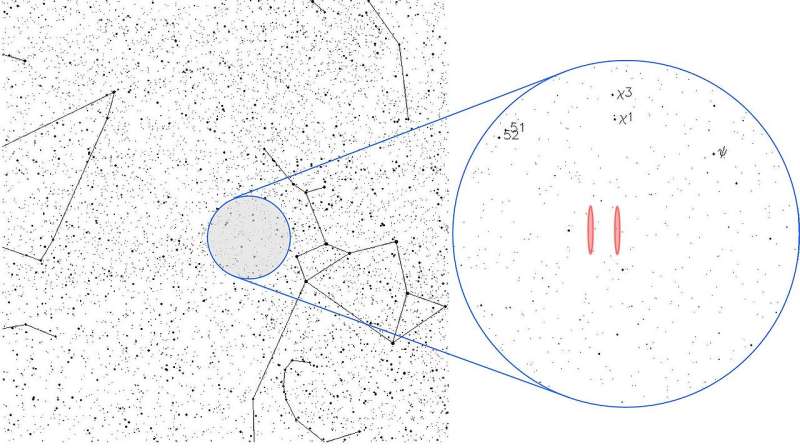The Wow! signal represented as "6EQUJ5". Credit: Big Ear Radio Observatory and North American AstroPhysical Observatory (NAAPO)
(Phys.org)—A team of researchers with the Center of Planetary Science (CPS) has finally solved the mystery of the "Wow!" signal from 1977. It was a comet, they report, one that that was unknown at the time of the signal discovery. Lead researcher Antonio Paris describes their theory and how the team proved it in a paper published in the Journal of the Washington Academy of Sciences.
Back in August of 1977, a team of astronomers studying radio transmissions from an observatory at Ohio State called the "Big Ear" recorded an unusual 72-second signal—it was so strong that team member Jerry Ehman scrawled "Wow!" next to the readout. Since that time, numerous scientists have searched for an explanation of the signal, but until now, no one could offer a valid argument. Possible sources such as asteroids, exo-planets, stars and even signals from Earth have all been ruled out. Some outside the science community even suggested that it was proof of aliens. It was noted that the frequency was transmitted at 1,420 MHz, though, which happens to be the same frequency as hydrogen.
The explanation started to come into focus last year when a team at the CPS suggested that the signal might have come from a hydrogen cloud accompanying a comet—additionally, the movement of the comet would explain why the signal was not seen again. The team noted that two comets had been in the same part of the sky that the Big Ear was monitoring on the fateful day. Those comets, P/2008 Y2(Gibbs) and 266/P Christensen had not yet been discovered. The team then got a chance to test their idea as the two comets appeared once again in the night sky from November 2016 through February of 2017.
Credit: The Center for Planetary Science
The team reports that radio signals from 266/P Christensen matched those from the Wow! signal 40 years ago. To verify their results, they tested readings from three other comets, as well, and found similar results. The researchers acknowledge that they cannot say with certainty that the Wow! signal was generated by 266/P Christensen, but they can say with relative assurance that it was generated by a comet.
More information: Hydrogen Line Observations of Cometary Spectra at 1420 MHZ , Journal of the Washington Academy of Sciences, planetary-science.org/research/the-wow-signal/ (Paper PDF)
ABSTRACT
In 2016, the Center for Planetary Science proposed a hypothesis arguing a comet and/or its hydrogen cloud were a strong candidate for the source of the "Wow!" Signal. From 27 November 2016 to 24 February 2017, the Center for Planetary Science conducted 200 observations in the radio spectrum to validate the hypothesis. The investigation discovered that comet 266/P Christensen emitted a radio signal at 1420.25 MHz. All radio emissions detected were within 1° (60 arcminutes) of the known celestial coordinates of the comet as it transited the neighborhood of the "Wow!" Signal. During observations of the comet, a series of experiments determined that known celestial sources at 1420 MHz (i.e., pulsars and/or active galactic nuclei) were not within 15° of comet 266/P Christensen. To dismiss the source of the signal as emission from comet 266/P Christensen, the position of the 10-meter radio telescope was moved 1° (60 arcminutes) away from comet 266/P Christensen. During this experiment, the 1420.25 MHz signal disappeared. When the radio telescope was repositioned back to comet 266/P Christensen, a radio signal at 1420.25 MHz reappeared. Furthermore, to determine if comets other than comet 266/P Christensen emit a radio signal at 1420 MHz, we observed three comets that were selected randomly from the JPL Small Bodies database: P/2013 EW90 (Tenagra), P/2016 J1-A (PANSTARRS), and 237P/LINEAR. During observations of these comets, we detected a radio signal at 1420 MHz. The results of this investigation, therefore, conclude that cometary spectra are detectable at 1420 MHz and, more importantly, that the 1977 "Wow!" Signal was a natural phenomenon from a Solar System body.
© 2017 Phys.org
























